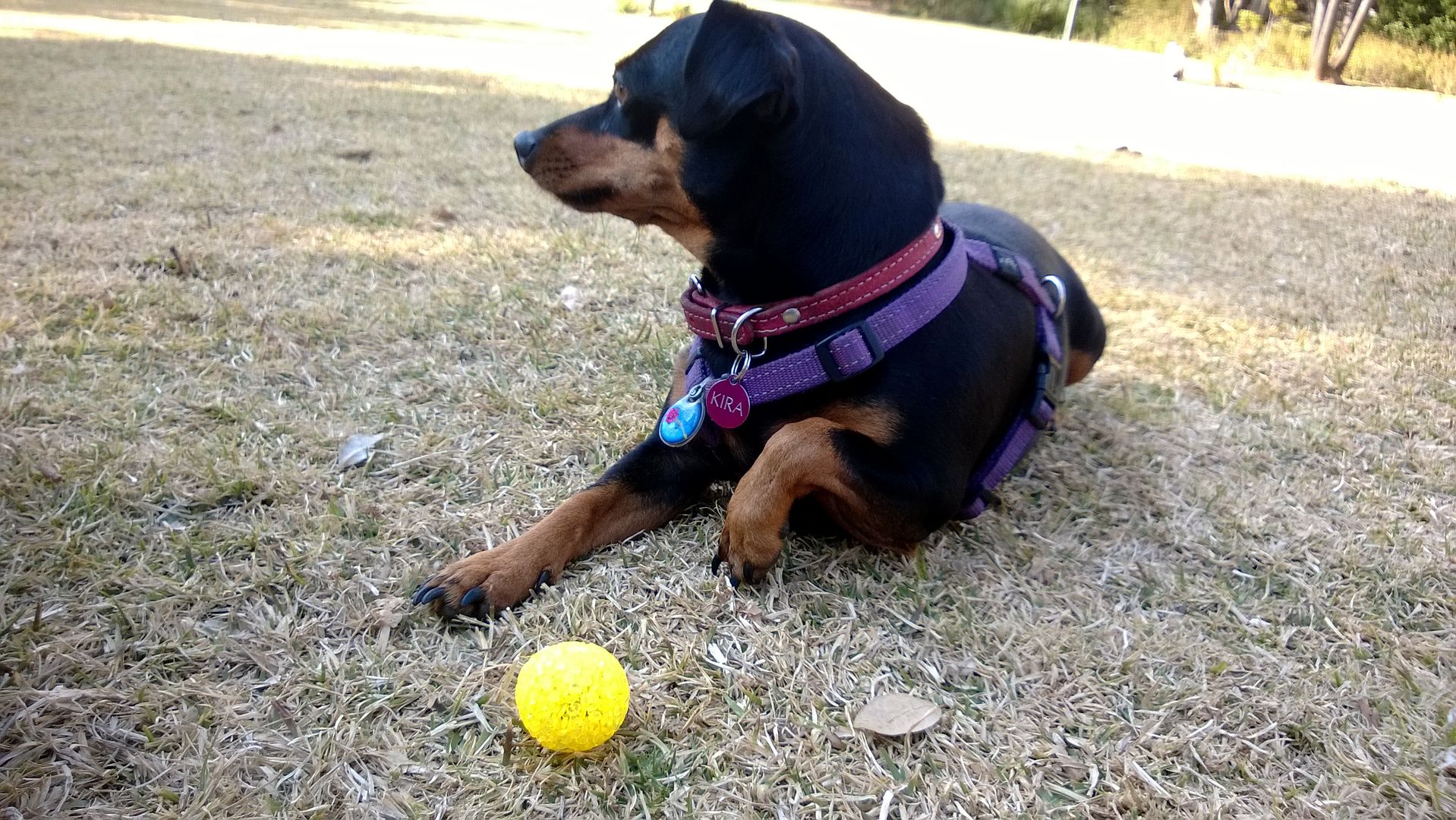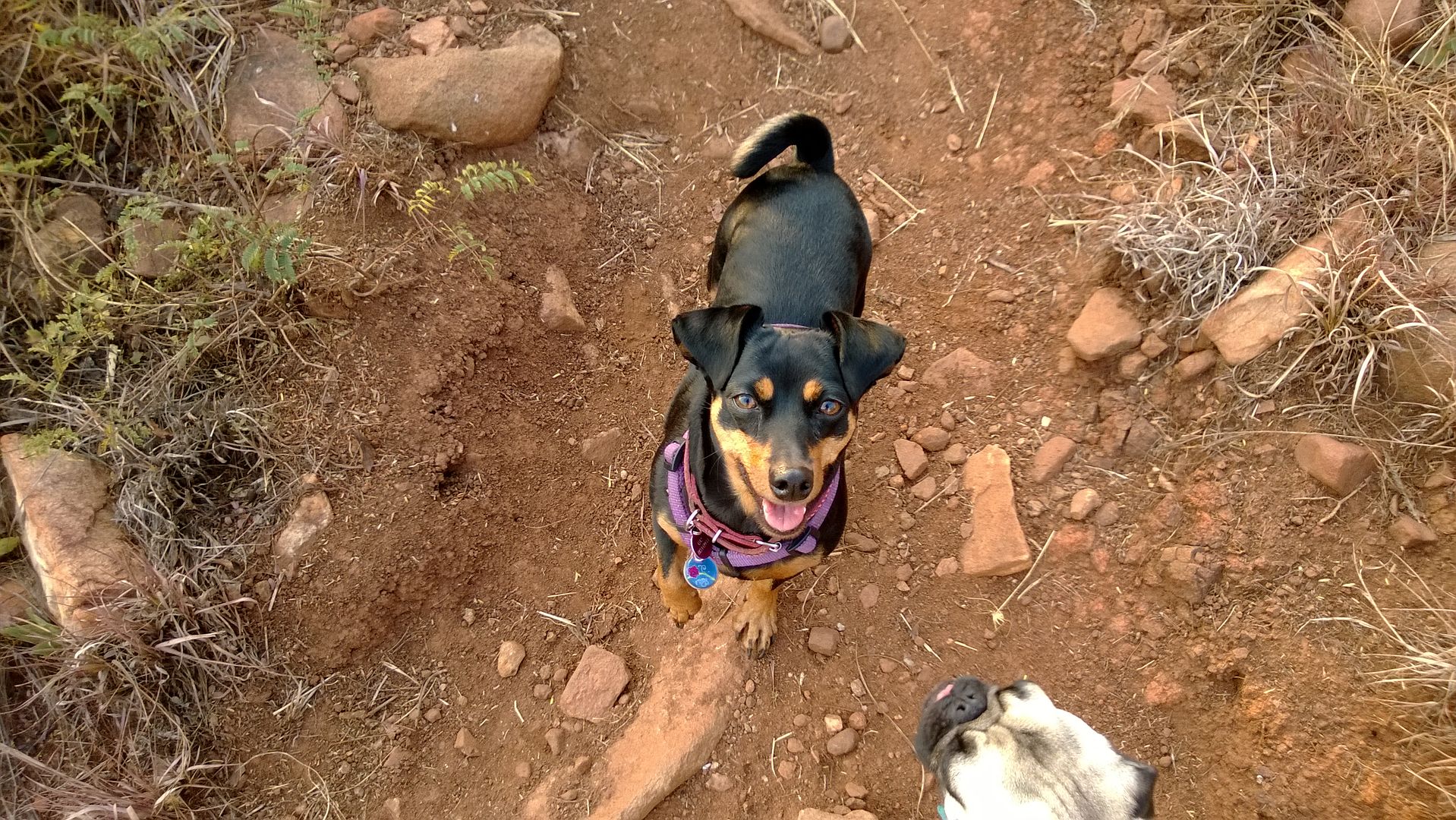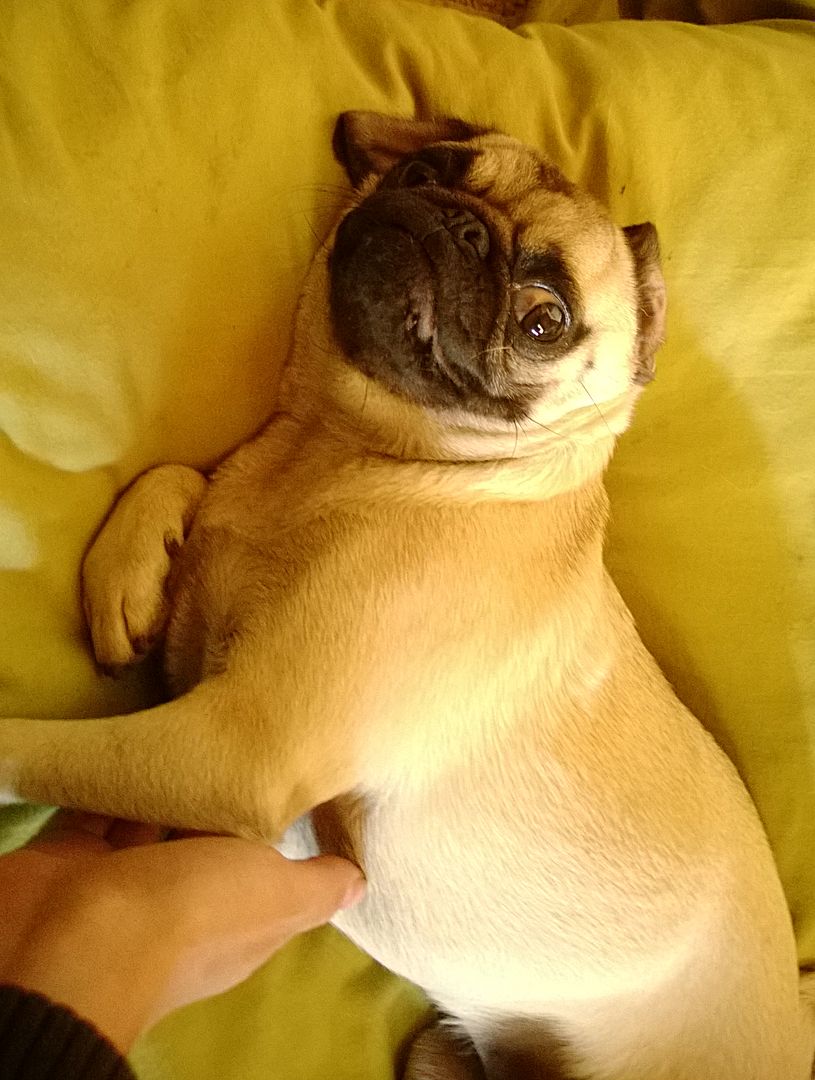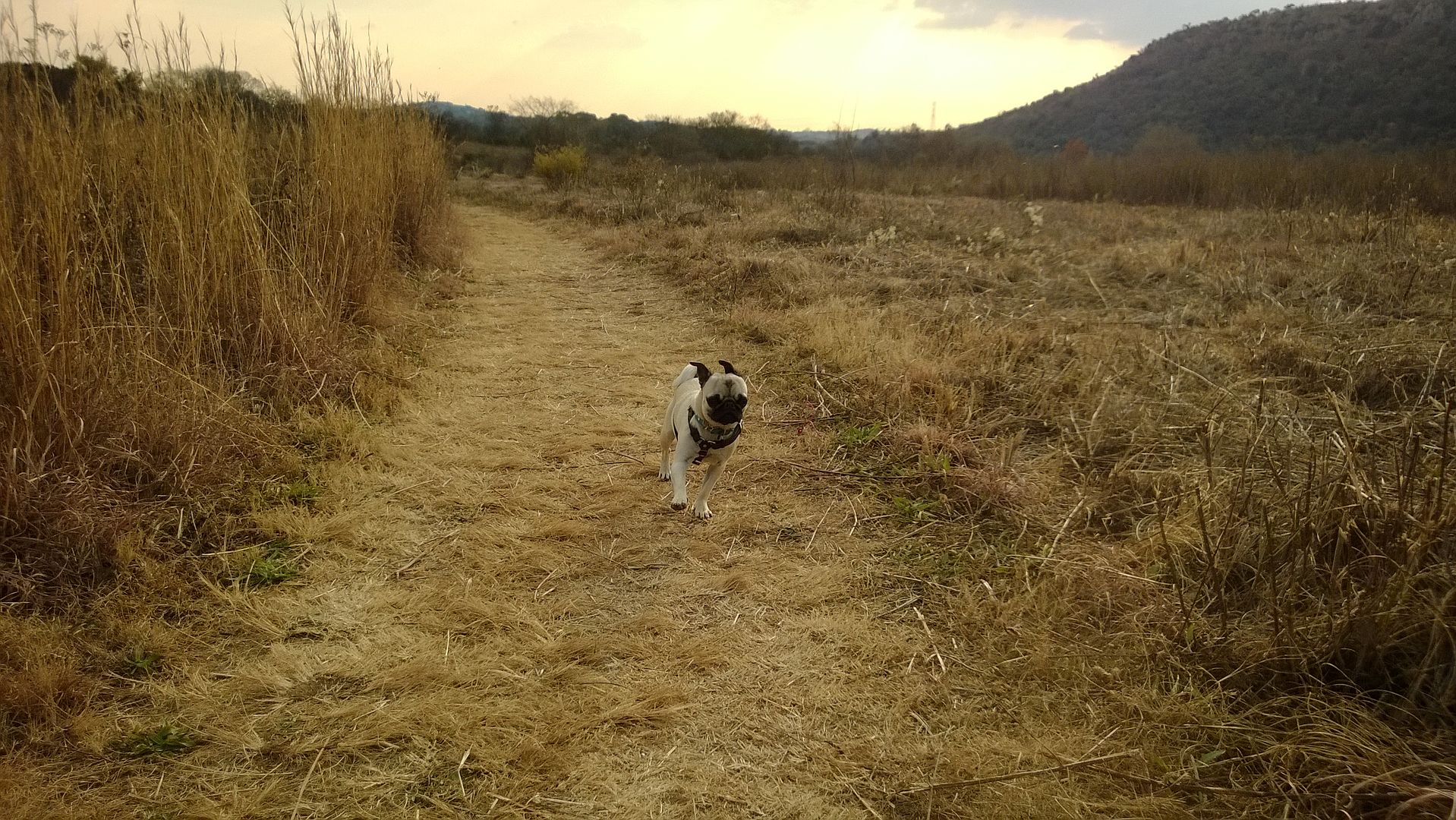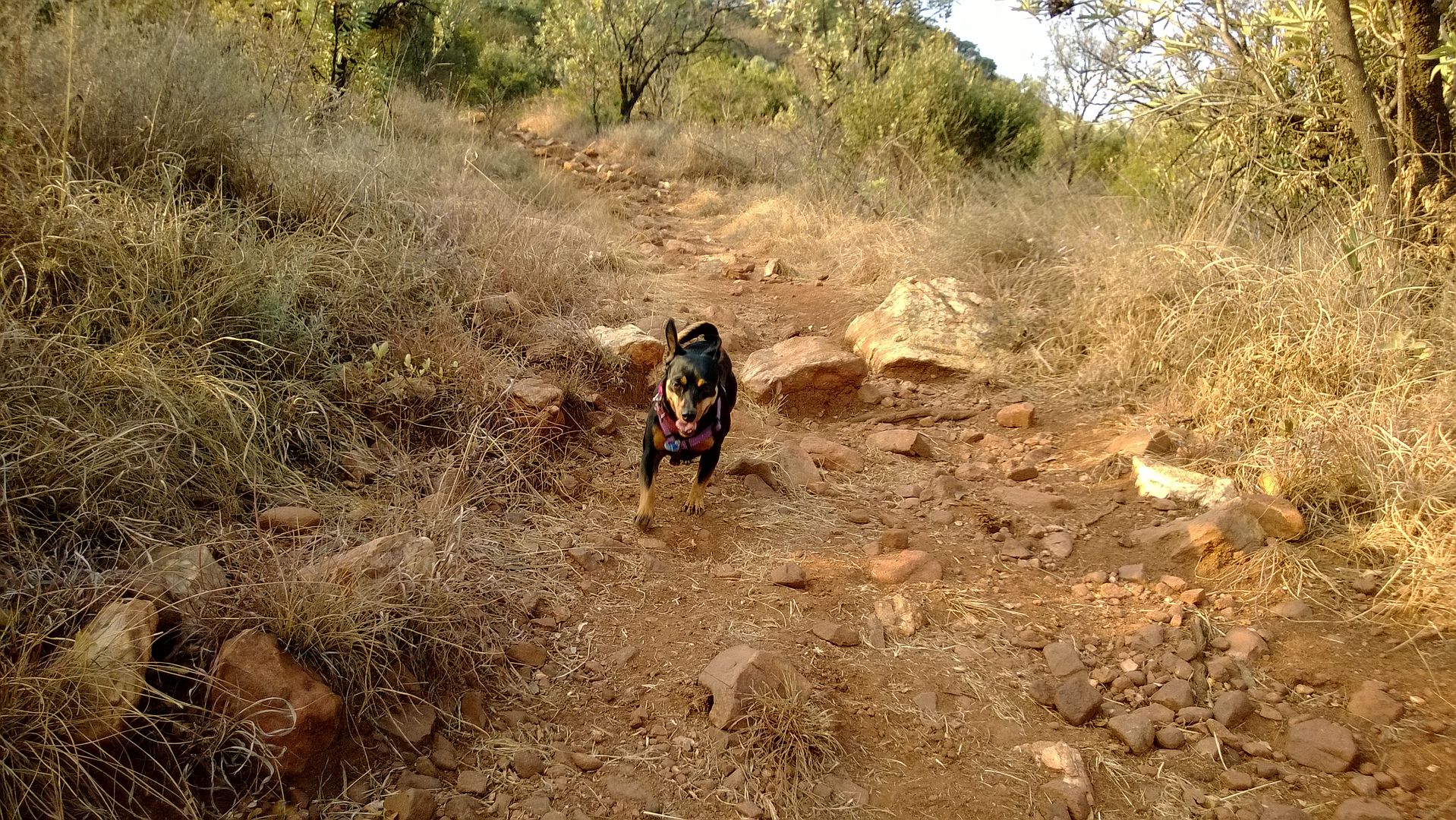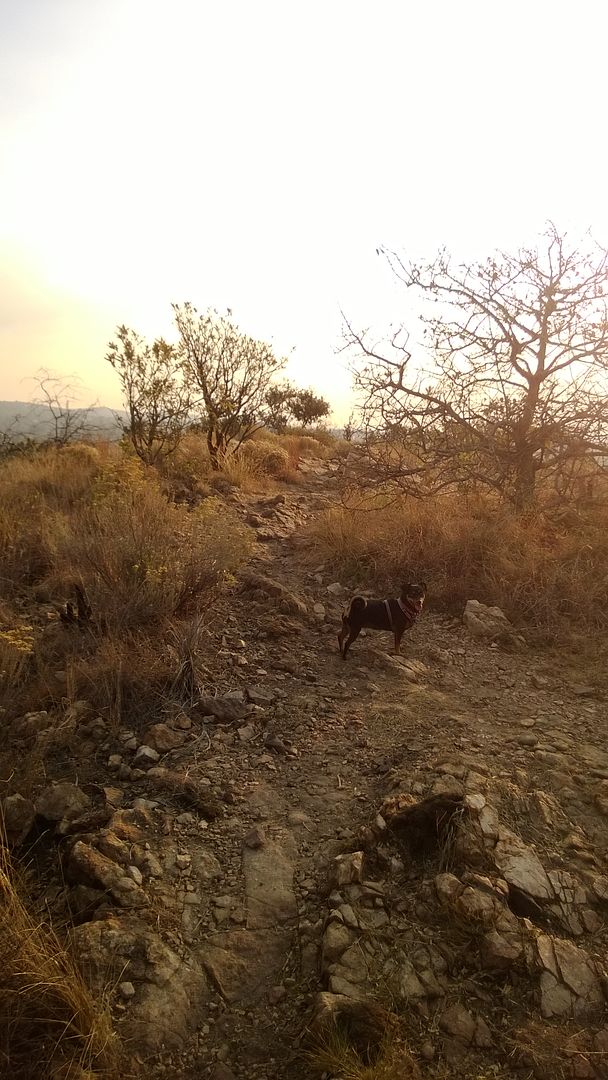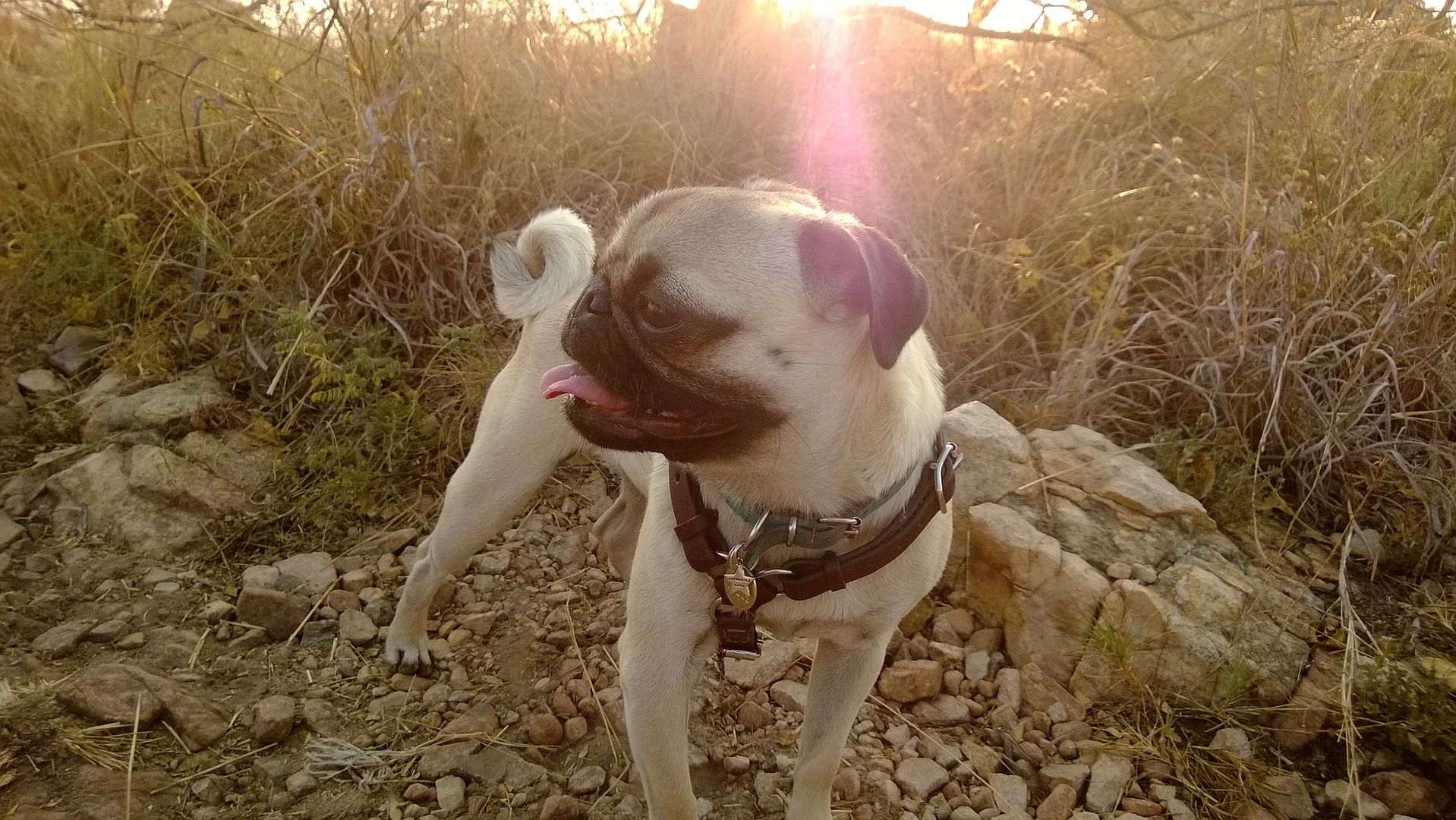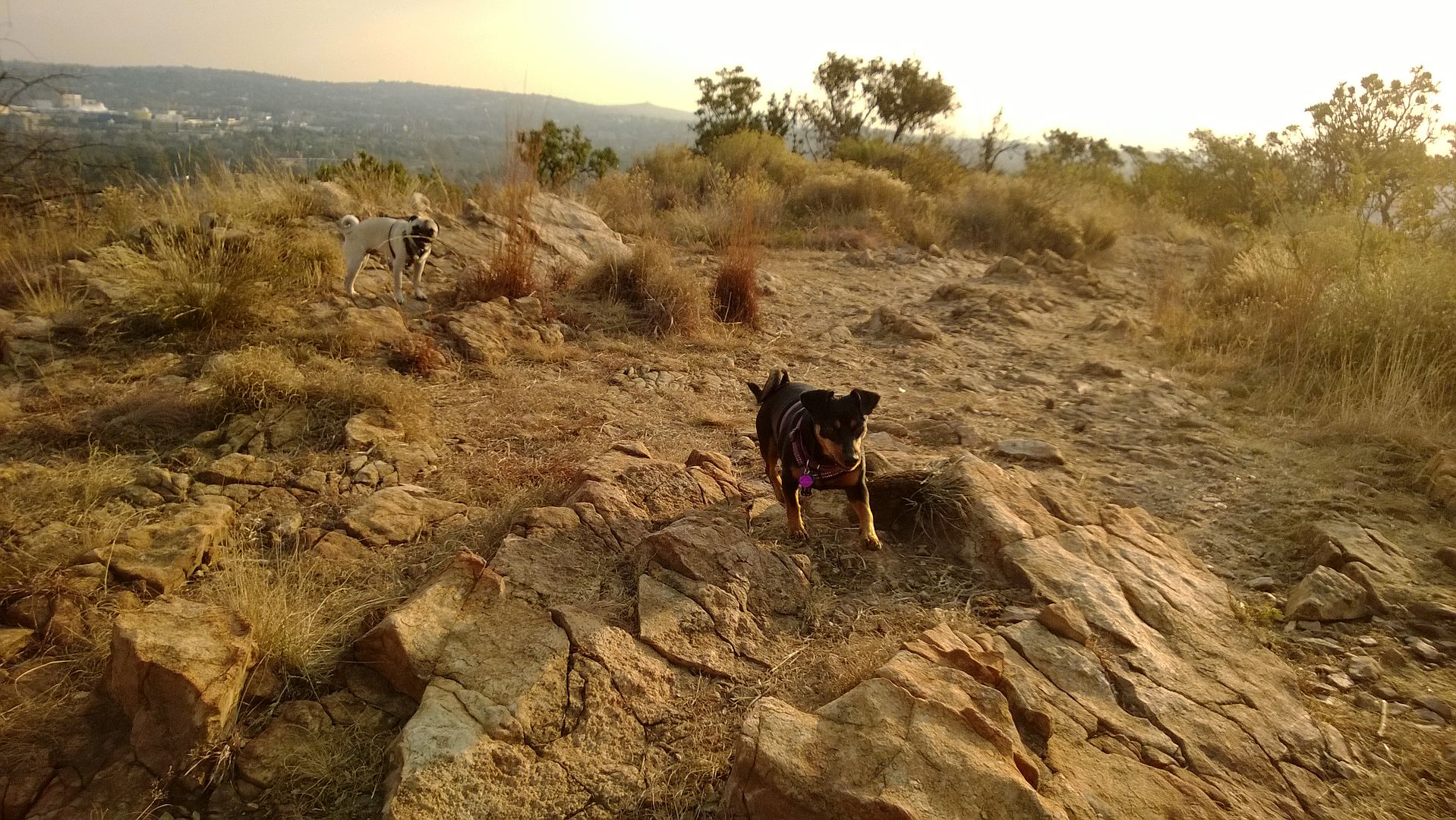There is something very, very cute about a dog standing knee deep in wildflowers.
Of course, it's also pretty much a matter of time before the dog knee deep in wildflowers encounters a bee. Prevention might be best, keeping them out of the flowers, but no one can watch their dog 100% of the time, and many dogs enjoy chasing these buzzy things that move in such a tantalising way ...
Which explains why most bee stings are to the dog's face.
Luckily, compared to a bee to the face, Kira just stepped on one.
Front left paw, poor girl. Second toe. I was woefully unprepared for any kind of accident (time to figure out a small, very portable emergency kit!). Kira, in turn, is not a big fan of having her feet messed with, and she's not shy with her teeth. 15 minutes of arguing to get the stinger out. Half an hour later, she was walking around, and another 15 minutes or so and she was running and playing happily.
Well, so that no one else has to be quite as unprepared as I was, here are some steps to take in case of a bee sting:
1. Be prepared. Get some anti-histamines from your vet, and keep a tweezer in your wallet.
2. Remove the stinger with tweezers, or, lacking that most useful tool, scrape it off with a card or a twig. Keep the card (twig) flat against the skin, and scrape to remove the stinger. Tucking your dog's head between your legs can help make an impromptu bite shield for your hands.
3. If you have clean water, washing the sting site helps make sure the stinger is out and helps prevent infection.
4. If there is swelling, give your dog the anti-histamine, and head home. Apply a cold compress to the area. If there is severe swelling, or any sign of breathing difficulty, go straight to the vet.
5. Once home, a baking soda poultice can help reduce minor swelling. Mix baking soda with just enough water to make a thick paste and use a wrap or a bandage to keep it on. Again, severe swelling warrants an emergency vet trip.
6. Monitor for the next 24 hours, at the first signs of respiratory distress, or if the swelling is not reduced, or if the swelling gets worse, head for the vet. You can repeat the cold compress as necessary.
Kira's foot still itched until late that night, but the next day, all swelling was gone, and she was not worrying it any more. She is luckily not allergic, had she been, we would not have waited out the worst of it in the park.
Thursday, 31 July 2014
Saturday, 26 July 2014
Saturday Limerick - What I see.
Shiny black doggy near me
With eyes bright and fur silky
Why do you smile
With such knowing guile?
Is that shreds of my book that I see?
Tuesday, 22 July 2014
In defense of the poorly bred pug
This gets a bit ranty... if you're not in that kind of mood, maybe stop reading when the pictures stop, ok?
As some of you may have noticed, Talos is a pug.
Her parents were pugs, and their parents were pugs, back for generations and generations. It's pugs pretty much all the way down.
She is a well trained pug.
She is a fit and in shape pug.
She is a happy pug.
Most importantly, though, she is a very, very loved pug.
She is also a poorly bred pug. By the pug breed standard, her legs and her back, proportional to her torso, are far too long. Her chest is not deep or broad enough. Her wrinkles are not pronounced enough. Her tail does not curl enough, nor is it set nice and high on her back. Her colour is less than great. She is too small over all, not big enough in absolute size, not wide enough, in a word, not as cobby as she should be had we been aiming for a well bred pug's appearance. She has an under bite too, just to round out this list.
She is definitely absolutely devoted to humans and food, rules the household, and is loving to a fault, like pugs should be. She is absolutely brilliant, which I myself think is also puggish, though many are said to be more beauty than brains. She is cautious of new people and new situations despite our best efforts at socialisation - not a puggish trait. She is energetic, and though she is still very young (19 months old), I suspect she won't slow down terribly much more than she is now until she is much older - this is also not a typically puggish trait.
Now, for the point of this navel gaze - the fact that she is not a 'well bred' pug by KUSA standards does not make her any less worthy as a dog. Insisting that the only pug that is worthy of being called a true pug, a typey pug, has a very narrowly defined set of pug attributes is perfectly fine. I am quite happy to have Talos recognised as a poorly bred pug by those standards. Making these evaluations on what a pug should look like is perfectly fine. After all, this is crucial to maintaining different dog breeds. But, that should never be a judgement on her value as a dog. An arbitrary standard of beauty should not be a reason to abandon, or to make unwanted, dogs like Talos - who, while perhaps not a standard pug, is a pretty darn amazing little creature.
As some of you may have noticed, Talos is a pug.
Her parents were pugs, and their parents were pugs, back for generations and generations. It's pugs pretty much all the way down.
She is a well trained pug.
She is a fit and in shape pug.
She is a happy pug.
Most importantly, though, she is a very, very loved pug.
She is also a poorly bred pug. By the pug breed standard, her legs and her back, proportional to her torso, are far too long. Her chest is not deep or broad enough. Her wrinkles are not pronounced enough. Her tail does not curl enough, nor is it set nice and high on her back. Her colour is less than great. She is too small over all, not big enough in absolute size, not wide enough, in a word, not as cobby as she should be had we been aiming for a well bred pug's appearance. She has an under bite too, just to round out this list.
She is definitely absolutely devoted to humans and food, rules the household, and is loving to a fault, like pugs should be. She is absolutely brilliant, which I myself think is also puggish, though many are said to be more beauty than brains. She is cautious of new people and new situations despite our best efforts at socialisation - not a puggish trait. She is energetic, and though she is still very young (19 months old), I suspect she won't slow down terribly much more than she is now until she is much older - this is also not a typically puggish trait.
Now, for the point of this navel gaze - the fact that she is not a 'well bred' pug by KUSA standards does not make her any less worthy as a dog. Insisting that the only pug that is worthy of being called a true pug, a typey pug, has a very narrowly defined set of pug attributes is perfectly fine. I am quite happy to have Talos recognised as a poorly bred pug by those standards. Making these evaluations on what a pug should look like is perfectly fine. After all, this is crucial to maintaining different dog breeds. But, that should never be a judgement on her value as a dog. An arbitrary standard of beauty should not be a reason to abandon, or to make unwanted, dogs like Talos - who, while perhaps not a standard pug, is a pretty darn amazing little creature.
Sunday, 20 July 2014
Tracheal collapse - or, skip the collar and use a harness.
The trachea, or wind pipe, of a dog, is a semi-rigid structure help open by c-shaped rings of cartilage, connected with a soft membrane, making a circle. Normally, the trachea is circular. Good breathing, facilitated by a healthy trachea (among other things, of course) is important not just for oxygen in the case of a dog, but also for keeping cool - they don't sweat, aside from their nose and the pads of their feet, so cool air in and hot air out as they breathe helps them regulate their temperature. It also helps evaporation off the surface of their tongue, another essential cooling mechanism.
Amongst dogs, but especially toy breed dogs, you get a condition known as tracheal collapse. This includes pugs, who are quite vulnerable to this condition . This is where the cartilage of the trachea has weakened enough that it does not remain circular, but in stead closes in on itself. In milder cases, it presents as a honking, dry cough, gagging and difficulty breathing. In more severe cases, a collapsed trachea can lead to severe respiratory distress and death (or a trip to the ER vet, and a night in an oxygen cage). Milder cases may have a relatively minor effect on quality of life - playing might have to be limited, and in extreme temperatures, your dog will have to stay in the cool, calm house. Severe cases can leave a dog pretty much perpetually crate bound. The condition is progressive, but progression can be managed.
We're not exactly sure what causes tracheal collapse, but heart issues, obesity, intubation, allergies, poor dental hygiene, the presence of a smoker in the household and respiratory infections are all associated with the condition.
There is little by way of treatment for tracheal collapse. Anti-inflammatory medications often help limit the swelling that accompanies tracheal collapse, which makes it all so much worse. Steroids can help for much the same reason. Limiting their exercise, and crucially, keeping them on the thin side of normal also helps. Having a home oxygen tank can really save you in a crucial moment. Elevating their food/water bowls so they need not lower their heads, providing a cushion for them to sleep on so they can keep their heads up at night and never leaving them alone (so that you don't miss a dangerous collapse episode) all helps to keep them going.
Surgically, a trachea can be tied back to keep it circular. Plastic rings are placed around the trachea, and the trachea is sutured to the rings. This treatment is often a lifesaver, but afterwards, the dogs are not like normal dogs (it's not a cure). Added to this, that when things do go wrong, they go very, very wrong.
There's also a procedure where a stent is placed along the trachea, a technique that seems to have positive outcomes too. The stents have a tendency to fail over time, and then need replacing.
Sometimes, a tracheotomy is done to 'bypass' the tracheal collapse by making a breathing hole in their throat. This requires that the dog be hand fed, to prevent food getting into their airways. The hole needs to be cleaned, since the cold air directly into the lungs leads to some mucus formation. The hole sometimes heals up too small, requiring a repeat surgery. This surgery is not always successful, is rarely recommended, and only sometimes gives satisfactory results.
Now, let me be clear, as far as I know, there has been no systematic, long term research showing that a collar causes tracheal collapse. It is common advice to recommend a collar be replaced with a harness once tracheal collapse has been diagnosed, and it is common advice to encourage small breed dog owners to use a harness, not a collar. There has also been some cases where use of a choke chain (oh, pardon me, euphemistically a 'slip collar' or a 'training collar') has lead to tracheal collapse - though many people would justifiably argue that this is misuse of a choke chain.
But, bare with me here. Let's look at those symptoms again:
And tell me, how does cartilage heal? (the answer is very slowly, and often imperfectly unless carefully managed) Do you think repeated pressure on a trachea could lead to damage?
And the last question - given that we have harnesses that put no, or much, much less pressure on the trachea than collars, is it worth the risk?
If you have a small dog, or a heavy puller, just don't take the risk. At least, that's what I think. You get superb tools to teach a dog not to pull without jerking their throats or their necks. You get easy to use training methods that do the same.
Here is a good article on tracheal collapse from the Journal of Veterinary Clinics of North America, volume 30, issue 6, November 2000:
http://www.2ndchance.info/dxme-BreathsPerMin-Johnson2000.pdf
As a final word, if you have a source for me that investigates collar use and tracheal collapse, I would greatly appreciate the reference.
Amongst dogs, but especially toy breed dogs, you get a condition known as tracheal collapse. This includes pugs, who are quite vulnerable to this condition . This is where the cartilage of the trachea has weakened enough that it does not remain circular, but in stead closes in on itself. In milder cases, it presents as a honking, dry cough, gagging and difficulty breathing. In more severe cases, a collapsed trachea can lead to severe respiratory distress and death (or a trip to the ER vet, and a night in an oxygen cage). Milder cases may have a relatively minor effect on quality of life - playing might have to be limited, and in extreme temperatures, your dog will have to stay in the cool, calm house. Severe cases can leave a dog pretty much perpetually crate bound. The condition is progressive, but progression can be managed.
We're not exactly sure what causes tracheal collapse, but heart issues, obesity, intubation, allergies, poor dental hygiene, the presence of a smoker in the household and respiratory infections are all associated with the condition.
There is little by way of treatment for tracheal collapse. Anti-inflammatory medications often help limit the swelling that accompanies tracheal collapse, which makes it all so much worse. Steroids can help for much the same reason. Limiting their exercise, and crucially, keeping them on the thin side of normal also helps. Having a home oxygen tank can really save you in a crucial moment. Elevating their food/water bowls so they need not lower their heads, providing a cushion for them to sleep on so they can keep their heads up at night and never leaving them alone (so that you don't miss a dangerous collapse episode) all helps to keep them going.
Surgically, a trachea can be tied back to keep it circular. Plastic rings are placed around the trachea, and the trachea is sutured to the rings. This treatment is often a lifesaver, but afterwards, the dogs are not like normal dogs (it's not a cure). Added to this, that when things do go wrong, they go very, very wrong.
There's also a procedure where a stent is placed along the trachea, a technique that seems to have positive outcomes too. The stents have a tendency to fail over time, and then need replacing.
Sometimes, a tracheotomy is done to 'bypass' the tracheal collapse by making a breathing hole in their throat. This requires that the dog be hand fed, to prevent food getting into their airways. The hole needs to be cleaned, since the cold air directly into the lungs leads to some mucus formation. The hole sometimes heals up too small, requiring a repeat surgery. This surgery is not always successful, is rarely recommended, and only sometimes gives satisfactory results.
Now, let me be clear, as far as I know, there has been no systematic, long term research showing that a collar causes tracheal collapse. It is common advice to recommend a collar be replaced with a harness once tracheal collapse has been diagnosed, and it is common advice to encourage small breed dog owners to use a harness, not a collar. There has also been some cases where use of a choke chain (oh, pardon me, euphemistically a 'slip collar' or a 'training collar') has lead to tracheal collapse - though many people would justifiably argue that this is misuse of a choke chain.
But, bare with me here. Let's look at those symptoms again:
- honking cough
- gagging
- choking
- difficulty breathing
And tell me, how does cartilage heal? (the answer is very slowly, and often imperfectly unless carefully managed) Do you think repeated pressure on a trachea could lead to damage?
And the last question - given that we have harnesses that put no, or much, much less pressure on the trachea than collars, is it worth the risk?
If you have a small dog, or a heavy puller, just don't take the risk. At least, that's what I think. You get superb tools to teach a dog not to pull without jerking their throats or their necks. You get easy to use training methods that do the same.
Here is a good article on tracheal collapse from the Journal of Veterinary Clinics of North America, volume 30, issue 6, November 2000:
http://www.2ndchance.info/dxme-BreathsPerMin-Johnson2000.pdf
As a final word, if you have a source for me that investigates collar use and tracheal collapse, I would greatly appreciate the reference.
Saturday, 19 July 2014
Saturday Limerick - Smug Pug!
For the next couple of weeks, I'll post a limerick inspired by Talos or Kira on a Saturday. Hopefully they amuse :)
Currently there is a pug
with that special look on her mug
That spells certain doom
for those in the room
Farting sure makes a pug smug!
with that special look on her mug
That spells certain doom
for those in the room
Farting sure makes a pug smug!
Friday, 11 July 2014
Cute puppies - don't get one.
Puppies are cute. Adorable, actually. Look at that face. That little pawsie. And aw, biting my toes!
Here are some more adorable puppies, not mine, not my pictures, but adorable:
Lookit the little great dane nosey-wosey!
An itty-bitty-pitty!
and... aw, a husky. Everyone's favourite with those blue eyes.
Why we find them cute is easy enough to understand. Most mammals are, by the nature of their hormones, bound to like baby mammals. Yep, scientifically, you think they're cute because your body thinks it's a baby, and you're wired to want to care for babies. (Seriously, don't take my word for it, here's a linky)
But, and I hope this is obvious, getting something because your hormones are screaming at you that it's a baby and you want to protect it and keep it safe is a pretty stupid thing to do. This is true of human babies (but thank the lucky stars our hormones do that, since babies really try their parents' patience), but it is especially true of puppies (or kitties, or bunnies, or fishies, or any animal that will be dependent on your benevolence and care for the duration of its life).
The thing is, that cute puppy grows really quickly. By five months, your adorable puppy is teething with all its might, and that little bite to your toe is now a needle-fanged piranha preventing you from walking barefoot, in socks, or even with loose laces. It's all fair game. Sure, it ends in a couple months, even if you teach them nothing (but teaching them helps a lot! ... oh, and is actually really important to avoid bite risk in the future ... another linky for you!).
By 8 months, we have entered adolescence, were their brain melts and runs out their ears. You, and your interests, take a second seat. That puppy that always came when you called is now running across the busy street at full tilt chasing a kid on a skateboard - something Fufu (what do you name bassets nowadays? Captain America? Bruce Wayne? I digress) has never done before. This is when you usually discover a new fitness regime, and either grow a patience muscle the size of a theoretical Olympic athlete specialised in the patience event or buy a crate (or toss the dog outside for the rest of its life, sigh).
As adolescence wanes (which, for small dogs, takes a couple months. For big dogs, you're in for another year or even two) and your dog takes on a young adult's persona, things become easier. Well, sort of. Did you get a husky? Congratulations on your running partner. An hour or more, a day, every day. Sound good? Awesome! You are one in a million people (I over exaggerate, but I am honestly frustrated by this) who actually got a dog you can adequately care for.
Every dog, even a pug (perhaps, especially a pug) needs 30 minutes of intense cardio, two to three times a week. Heck, you do too, but you're considered a human, and so can decide for yourself how much you care about your own health. This can be a rowdy game of tug, fetch or flirt-pole chasing. This can be swimming, or sprinting, or zoomies. This can be anything, as long as that heart rate gets up there and stays up there. Strong bones, strong muscles, and a happier dog. Some really athletic dogs (australian cattle dogs, collies, pitt bulls, huskies ... most working dogs would fall into this category) will need much, much more than this. I'm pretty sure Aussies can do this all day and still be ready for more.
This has not yet occupied your pet's mind. Yes, your dog has a brain, and in some cases, they may even be smarter than you. I know Talos has me outsmarted often, and her brain is the size of two thumbs squished together. Take that, ego!
One of the easiest ways to occupy their minds is to take them for a walk. New sights, but most importantly, new smells, really gets them thinking. With smaller, less fit dogs, this walk can sometimes provide enough exercise too - given a good hour and a daily frequency. With bigger dogs, and more athletic dogs, it won't. Other ideas include nose-work, training, puzzles, climbing (both a physical and a mental challenge - "find a way up this boulder, Piddles"! (Piddles is, of course, a rottweiller. Maybe 'Mayhem' or 'G.I. Joe' would be better?)
That was the fun part. Your pup will need bathing (if you're me, this is weekly), nail clips (this should be weekly, and yes, dog owner over there that hasn't done it in a couple months, I'm looking at you!), parasite protection both internal and external, both manual (tick removal is fun, yo...) and chemical. They will need specialised care according to their breed (wrinkle wipes, face wipes, butt squeezies (sigh, alright, emptying anal sacs) ear cleanings, paw cleanings, fur brushings, and so on). They will need food, and it will cost more than you thought to get them the even moderately good stuff (which you really should. The bad stuff is really, really bad). They will need to go to the vet. They won't like it, they will be harder to manage than you could ever have imagined, and all your training will fail and fail and fail before you succeed. Vet bills will be astronomical.
Then there's the sad part. Your pup will get old. They'll need your care in the last years of their life. The fun stuff slowly shrinks and is replaced by sleep. They will get old, and fragile.
Dumping them in the pound is never an option simply because they are old. There are always better alternatives, even putting them to sleep (which will happen anyway in the pound, just with your dog scared, lonely and abandoned).
I think we should sell puppies with old dog faces. Here! Get this adorable dog! He adores humans but has a death wish around big dogs, pees pretty much where he likes (including women's legs), barks at things that don't exist, can't hear, can't see very well, and is likely a little demented. He has a dodgy hip and he really can't walk half a block before you'll need to carry him. He will love you more than you can ever understand, and you will never be the same as before he came. Dog pictured may take over 13 years of dedicated assembly.
Here are some more adorable puppies, not mine, not my pictures, but adorable:
Lookit the little great dane nosey-wosey!
An itty-bitty-pitty!
and... aw, a husky. Everyone's favourite with those blue eyes.
Why we find them cute is easy enough to understand. Most mammals are, by the nature of their hormones, bound to like baby mammals. Yep, scientifically, you think they're cute because your body thinks it's a baby, and you're wired to want to care for babies. (Seriously, don't take my word for it, here's a linky)
But, and I hope this is obvious, getting something because your hormones are screaming at you that it's a baby and you want to protect it and keep it safe is a pretty stupid thing to do. This is true of human babies (but thank the lucky stars our hormones do that, since babies really try their parents' patience), but it is especially true of puppies (or kitties, or bunnies, or fishies, or any animal that will be dependent on your benevolence and care for the duration of its life).
The thing is, that cute puppy grows really quickly. By five months, your adorable puppy is teething with all its might, and that little bite to your toe is now a needle-fanged piranha preventing you from walking barefoot, in socks, or even with loose laces. It's all fair game. Sure, it ends in a couple months, even if you teach them nothing (but teaching them helps a lot! ... oh, and is actually really important to avoid bite risk in the future ... another linky for you!).
By 8 months, we have entered adolescence, were their brain melts and runs out their ears. You, and your interests, take a second seat. That puppy that always came when you called is now running across the busy street at full tilt chasing a kid on a skateboard - something Fufu (what do you name bassets nowadays? Captain America? Bruce Wayne? I digress) has never done before. This is when you usually discover a new fitness regime, and either grow a patience muscle the size of a theoretical Olympic athlete specialised in the patience event or buy a crate (or toss the dog outside for the rest of its life, sigh).
As adolescence wanes (which, for small dogs, takes a couple months. For big dogs, you're in for another year or even two) and your dog takes on a young adult's persona, things become easier. Well, sort of. Did you get a husky? Congratulations on your running partner. An hour or more, a day, every day. Sound good? Awesome! You are one in a million people (I over exaggerate, but I am honestly frustrated by this) who actually got a dog you can adequately care for.
Every dog, even a pug (perhaps, especially a pug) needs 30 minutes of intense cardio, two to three times a week. Heck, you do too, but you're considered a human, and so can decide for yourself how much you care about your own health. This can be a rowdy game of tug, fetch or flirt-pole chasing. This can be swimming, or sprinting, or zoomies. This can be anything, as long as that heart rate gets up there and stays up there. Strong bones, strong muscles, and a happier dog. Some really athletic dogs (australian cattle dogs, collies, pitt bulls, huskies ... most working dogs would fall into this category) will need much, much more than this. I'm pretty sure Aussies can do this all day and still be ready for more.
This has not yet occupied your pet's mind. Yes, your dog has a brain, and in some cases, they may even be smarter than you. I know Talos has me outsmarted often, and her brain is the size of two thumbs squished together. Take that, ego!
One of the easiest ways to occupy their minds is to take them for a walk. New sights, but most importantly, new smells, really gets them thinking. With smaller, less fit dogs, this walk can sometimes provide enough exercise too - given a good hour and a daily frequency. With bigger dogs, and more athletic dogs, it won't. Other ideas include nose-work, training, puzzles, climbing (both a physical and a mental challenge - "find a way up this boulder, Piddles"! (Piddles is, of course, a rottweiller. Maybe 'Mayhem' or 'G.I. Joe' would be better?)
That was the fun part. Your pup will need bathing (if you're me, this is weekly), nail clips (this should be weekly, and yes, dog owner over there that hasn't done it in a couple months, I'm looking at you!), parasite protection both internal and external, both manual (tick removal is fun, yo...) and chemical. They will need specialised care according to their breed (wrinkle wipes, face wipes, butt squeezies (sigh, alright, emptying anal sacs) ear cleanings, paw cleanings, fur brushings, and so on). They will need food, and it will cost more than you thought to get them the even moderately good stuff (which you really should. The bad stuff is really, really bad). They will need to go to the vet. They won't like it, they will be harder to manage than you could ever have imagined, and all your training will fail and fail and fail before you succeed. Vet bills will be astronomical.
Then there's the sad part. Your pup will get old. They'll need your care in the last years of their life. The fun stuff slowly shrinks and is replaced by sleep. They will get old, and fragile.
Dumping them in the pound is never an option simply because they are old. There are always better alternatives, even putting them to sleep (which will happen anyway in the pound, just with your dog scared, lonely and abandoned).
I think we should sell puppies with old dog faces. Here! Get this adorable dog! He adores humans but has a death wish around big dogs, pees pretty much where he likes (including women's legs), barks at things that don't exist, can't hear, can't see very well, and is likely a little demented. He has a dodgy hip and he really can't walk half a block before you'll need to carry him. He will love you more than you can ever understand, and you will never be the same as before he came. Dog pictured may take over 13 years of dedicated assembly.
Labels:
cruelty,
dog behaviour,
dog health,
every day life,
play,
pug,
puppy,
Talos,
Zakkie
The pug life!
Hello everyone, Talos here! Nina here too, we're co-writing.
Today, I want to tell you about a typical day in my life. It starts, like any good day, in a nice warm bed, with a faithful warm human placed next to me.
Don't you dare believe that she makes getting up easy. As you sit up to try and escape her warm, fuzzy clutches, she shifts her position and puts her paws around you to try and keep you down. Eventually, though, we manage to escape the pug's ridiculously soft and snuggly warmth, and get dressed for the day.
After letting them get my breakfast ready while I snooze in the warm bed, I get up and eat my portion - which I'll have you know is perpetually too small. I forgive them this indiscretion, though, (just barely, the looks you get when that bowl is empty!) because after this, I settle down on my softer human's lap for my morning nap. She makes soothing clickety-click sounds while the laptop hums soothingly, and I just drift away. Sometimes she struggles with something, and I help her by bashing on the keyboard a bit until the computer goes 'beeeeeeep'. That means it's fixed!
Talos occupies my left elbow crook. This is her elbow, she has claimed it, and I have simply learnt to type from a new position. It no longer gets stiff or sore like it used to. Takes about six months for a human to fully adjust, I guess. Oh, and yes, she does honestly sometimes bash the keyboard. And yes, it does make programs crash. BSOD... her middle name, perhaps? On the plus side, I've developed great saving habits.
Not long after morning nap, the daily ritual of cruelty happens. My human sits there, and eats delicious food, while I have to stare and watch. It's inhumane! Inhumane, I tell you!
Lunch. It's called lunch. Which you don't get, because two meals (and a million treats in between) gives you enough food to remain at a good weight. I get lunch because you tire my arm out, and I need the boost mid-day.
I don't tire your arm out! I barely weigh anything - and whose fault is that? Oh, wait, you said treats!
TREATS!
Into my mouth! NOW!
Ok, ok, I'll settle for playtime. Afternoons are all about my playtime, yes? Wait a minute, why am I asking? Human, play time! Let's go!
We do some training during 'playtime' too, at the moment it's front crosses and learning to weave with a channel.
After afternoon playtime it's walkies! I love walkies :)
Then, dinner and sleep, and I get to do it all over again!
Today, I want to tell you about a typical day in my life. It starts, like any good day, in a nice warm bed, with a faithful warm human placed next to me.
Don't you dare believe that she makes getting up easy. As you sit up to try and escape her warm, fuzzy clutches, she shifts her position and puts her paws around you to try and keep you down. Eventually, though, we manage to escape the pug's ridiculously soft and snuggly warmth, and get dressed for the day.
After letting them get my breakfast ready while I snooze in the warm bed, I get up and eat my portion - which I'll have you know is perpetually too small. I forgive them this indiscretion, though, (just barely, the looks you get when that bowl is empty!) because after this, I settle down on my softer human's lap for my morning nap. She makes soothing clickety-click sounds while the laptop hums soothingly, and I just drift away. Sometimes she struggles with something, and I help her by bashing on the keyboard a bit until the computer goes 'beeeeeeep'. That means it's fixed!
Talos occupies my left elbow crook. This is her elbow, she has claimed it, and I have simply learnt to type from a new position. It no longer gets stiff or sore like it used to. Takes about six months for a human to fully adjust, I guess. Oh, and yes, she does honestly sometimes bash the keyboard. And yes, it does make programs crash. BSOD... her middle name, perhaps? On the plus side, I've developed great saving habits.
Not long after morning nap, the daily ritual of cruelty happens. My human sits there, and eats delicious food, while I have to stare and watch. It's inhumane! Inhumane, I tell you!
Lunch. It's called lunch. Which you don't get, because two meals (and a million treats in between) gives you enough food to remain at a good weight. I get lunch because you tire my arm out, and I need the boost mid-day.
I don't tire your arm out! I barely weigh anything - and whose fault is that? Oh, wait, you said treats!
TREATS!
Into my mouth! NOW!
Ok, ok, I'll settle for playtime. Afternoons are all about my playtime, yes? Wait a minute, why am I asking? Human, play time! Let's go!
We do some training during 'playtime' too, at the moment it's front crosses and learning to weave with a channel.
After afternoon playtime it's walkies! I love walkies :)
Tuesday, 8 July 2014
Cold day
It's an unusually cold winters day today. Not unusual for winter, there's a few like this every year, but this is not every-day kind of winter cold, it's cold-front-passing-over winter cold.
... and the cold makes me silly. Which I take out on my dogs. So, in stead of their harnesses for our walk tonight, they wore ...
Their dresses!
Talos in pink.
Kira in purple.
That is all! :D
P.S.
Keep your doggies warm on these chilly days, especially the little ones and the old ones - their ability to regulate their own body temperature is limited. I mean, you don't need a frilly dress and all that (even though they are awesome, and yes, a boy dog can absolutely wear frills!), but a blankie and a hot water bottle goes a long way.
... and the cold makes me silly. Which I take out on my dogs. So, in stead of their harnesses for our walk tonight, they wore ...
Their dresses!
Talos in pink.
Kira in purple.
That is all! :D
P.S.
Keep your doggies warm on these chilly days, especially the little ones and the old ones - their ability to regulate their own body temperature is limited. I mean, you don't need a frilly dress and all that (even though they are awesome, and yes, a boy dog can absolutely wear frills!), but a blankie and a hot water bottle goes a long way.
Tuesday, 1 July 2014
Spotted... The South African Wild-Pug
Day 1
Today, we set off on the greatest adventure of our lives! We have set up camp out in Faerie Glen Nature reserve, in the capital city of South Africa, one of the few remaining natural areas where we might find the South African wild-pug. Pugs are by no measure endangered locally, but most are domesticated lap warmers and bed-pugs, bearing little resemblance to their wild cousins. Or so I've heard! I cannot wait to see one.
...
Day 14
A hair! We think we've found a pug hair. Just one, though, which is suspicious. We've sent it off to the lab for confirmation. Oh, how I hope!
...
Day 35
With it's wild ranges increasingly threatened by rapid urbanisation that is so characteristic of developing countries, our odds of spotting the South African wild-pug was bleak from the start. The lure of warm houses with ready food supplies has decimated wild-pug numbers. But it's been more than a month, and so far, not even a hair has been found. Yes, the lab results are back... it was a cat hair. This is so disheartening. The wild-pug sheds profusely, using this abundance of hair to mark their territory. This is unique among wild domestic canids. Surely there should be some sign by now?
We will persevere, even though I am demotivated. At least our pug-sniffing hound, chosen for her curly tail, which should be a sign of solidarity to the wild pug, seems content.
These hills are made for the delight of small dogs, that much is obvious.
Day 36
We have changed tactics. We have decided, against our better moral judgement, that we shall use food to lure a wild pug to us. Yes, we are risking further reducing the wild population, but what choice do we have? We must study them somehow.
Day 36 - mid day
What a success! It had barely warmed up from the frosty winter morning when suddenly, we spotted it!
Approaching from the tall grass, cautiously. The majestic African Wild-Pug.
After scenting the food, it came running along the beaten down grass path where we set up camp.
It ate, and ate, and ate! You would not believe it! We got so close to it too! Close enough to see it's a female. We've decided to call it 'Specimen Alpha'.
When Specimen Alpha had eaten all the food, she took one look at us, peed on the boots of our expedition leader, and disappeared into the grass from where she came.
We will leave out food again tomorrow.
Day 37
Before we got a chance to set out food this morning, our pug-sniffing hound found her scent. Is it a risk to follow this trail? Will the wild-pug disappear if we come near its lair?
We followed, carrying food (the banana was eaten first yesterday, so we're taking extra of that). Hopefully, bearing gifts will put Specimen Alpha at ease.
Day 38
The trail is much longer than we anticipated. The wild-pug's speed and agility are noteworthy. We're still heading into the hills, pug-sniffing hound leading us as quickly as we can follow.
We are not small, agile dogs. We stomp along the rocky outcrop, we stumble on the loose rocks. We have none of the grace and poise of a wild pug.
Day 39
Just as we thought our pug-sniffing hound was leading us on a wild-goose chase, because yet another day what coming to an end, what appeared between the rocks but Specimen Alpha?!
She seems perfectly adapted to her environment. Even the light seems to converge to accentuate her best features.
Her legs are lean and long, her tail curled just like our pug-sniffer. Her teeth are white, her under-bite noticeable, and her eyes dark, like molten chocolate. Her ears are black, and seem to change form from moment to moment. She ate the bananas with great enthusiasm. She seems smaller and more timid than domesticated specimens.
The sun was setting, though, so we had to turn back much sooner than we would have liked. Our pug-sniffing hound seemed to know something before we did. She kept smiling at us.
We tried to say goodbye to Specimen Alpha, truly we did.
But she simply followed us.
So, we gave up. What can we learn from wild pug behaviour, other than a very large preference for human foods over what they can find in nature? Off we went into the sunset, now with one more member in our expedition. Was this the last wild pug? As she sleeps on my lap, I almost find myself hoping so. Truly, these dogs should be around humans. We are simply happier with them around.
Today, we set off on the greatest adventure of our lives! We have set up camp out in Faerie Glen Nature reserve, in the capital city of South Africa, one of the few remaining natural areas where we might find the South African wild-pug. Pugs are by no measure endangered locally, but most are domesticated lap warmers and bed-pugs, bearing little resemblance to their wild cousins. Or so I've heard! I cannot wait to see one.
...
Day 14
A hair! We think we've found a pug hair. Just one, though, which is suspicious. We've sent it off to the lab for confirmation. Oh, how I hope!
...
Day 35
With it's wild ranges increasingly threatened by rapid urbanisation that is so characteristic of developing countries, our odds of spotting the South African wild-pug was bleak from the start. The lure of warm houses with ready food supplies has decimated wild-pug numbers. But it's been more than a month, and so far, not even a hair has been found. Yes, the lab results are back... it was a cat hair. This is so disheartening. The wild-pug sheds profusely, using this abundance of hair to mark their territory. This is unique among wild domestic canids. Surely there should be some sign by now?
We will persevere, even though I am demotivated. At least our pug-sniffing hound, chosen for her curly tail, which should be a sign of solidarity to the wild pug, seems content.
These hills are made for the delight of small dogs, that much is obvious.
Day 36
We have changed tactics. We have decided, against our better moral judgement, that we shall use food to lure a wild pug to us. Yes, we are risking further reducing the wild population, but what choice do we have? We must study them somehow.
Day 36 - mid day
What a success! It had barely warmed up from the frosty winter morning when suddenly, we spotted it!
Approaching from the tall grass, cautiously. The majestic African Wild-Pug.
After scenting the food, it came running along the beaten down grass path where we set up camp.
It ate, and ate, and ate! You would not believe it! We got so close to it too! Close enough to see it's a female. We've decided to call it 'Specimen Alpha'.
When Specimen Alpha had eaten all the food, she took one look at us, peed on the boots of our expedition leader, and disappeared into the grass from where she came.
We will leave out food again tomorrow.
Day 37
Before we got a chance to set out food this morning, our pug-sniffing hound found her scent. Is it a risk to follow this trail? Will the wild-pug disappear if we come near its lair?
We followed, carrying food (the banana was eaten first yesterday, so we're taking extra of that). Hopefully, bearing gifts will put Specimen Alpha at ease.
Day 38
The trail is much longer than we anticipated. The wild-pug's speed and agility are noteworthy. We're still heading into the hills, pug-sniffing hound leading us as quickly as we can follow.
We are not small, agile dogs. We stomp along the rocky outcrop, we stumble on the loose rocks. We have none of the grace and poise of a wild pug.
Day 39
Just as we thought our pug-sniffing hound was leading us on a wild-goose chase, because yet another day what coming to an end, what appeared between the rocks but Specimen Alpha?!
She seems perfectly adapted to her environment. Even the light seems to converge to accentuate her best features.
Her legs are lean and long, her tail curled just like our pug-sniffer. Her teeth are white, her under-bite noticeable, and her eyes dark, like molten chocolate. Her ears are black, and seem to change form from moment to moment. She ate the bananas with great enthusiasm. She seems smaller and more timid than domesticated specimens.
The sun was setting, though, so we had to turn back much sooner than we would have liked. Our pug-sniffing hound seemed to know something before we did. She kept smiling at us.
We tried to say goodbye to Specimen Alpha, truly we did.
But she simply followed us.
So, we gave up. What can we learn from wild pug behaviour, other than a very large preference for human foods over what they can find in nature? Off we went into the sunset, now with one more member in our expedition. Was this the last wild pug? As she sleeps on my lap, I almost find myself hoping so. Truly, these dogs should be around humans. We are simply happier with them around.
Subscribe to:
Posts (Atom)

